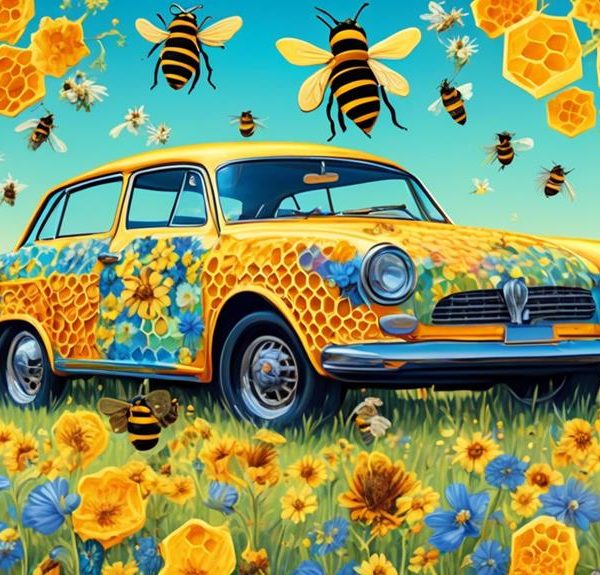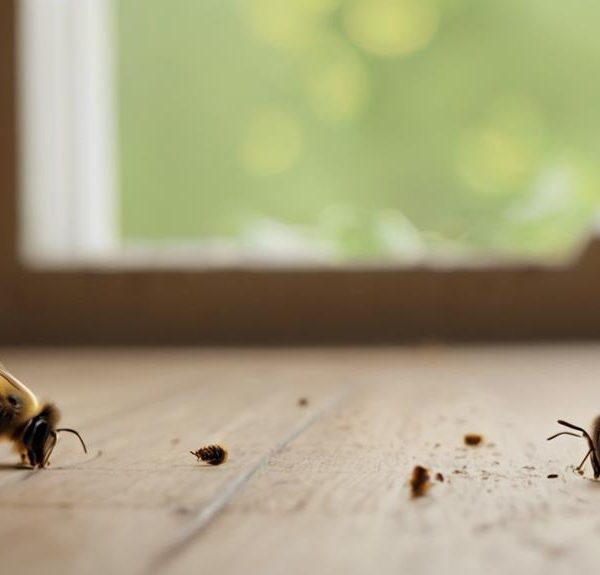Learn about the intriguing reasons behind bumble bees' aggressive confrontations, revealing a hidden world of territorial disputes and mating rights.
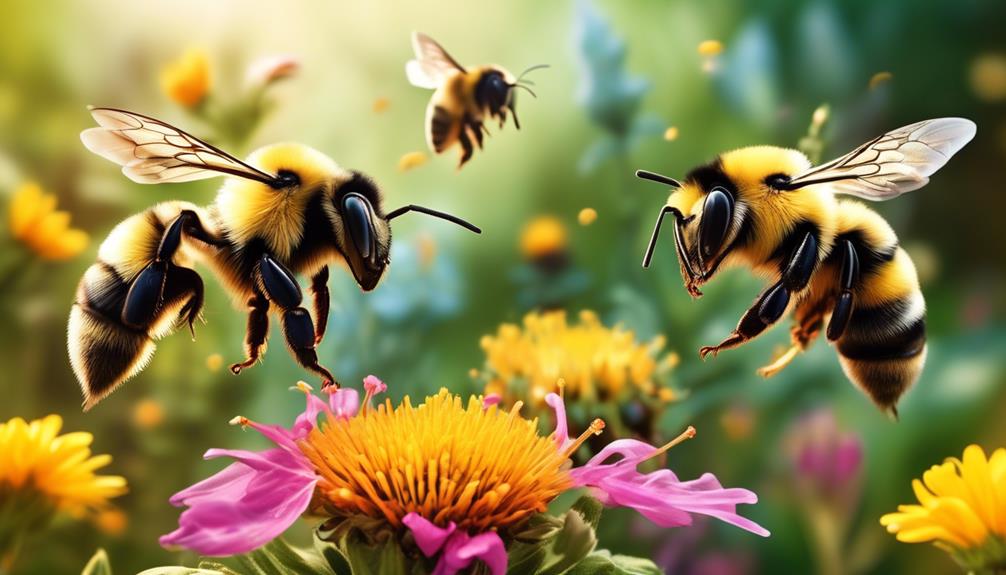
Why Do Bumble Bees Fight Each Other?
Like gladiators in a buzzing arena, bumble bees often engage in fierce battles with each other. You might've observed this fascinating spectacle in your own backyard, wondering why these tiny creatures resort to such aggressive behavior.
Various factors, such as territorial disputes and mating rights, play a significant role in these interactions. But, is there more to this seemingly chaotic dance of dominance among our friendly pollinators?
Let's embark on a journey to unravel the nuances of these bumble bee battles, revealing a world that may change your understanding of these industrious insects forever.
Key Takeaways
- Bumble bees fight each other due to territorial disputes, as they need to secure resources and maintain colony dominance.
- Mating battles among bumble bees are fierce, with only the most vigorous drones and new queens participating, as they fight to secure their genetic material.
- Aggression levels in bumble bees can be influenced by factors such as temperature, food availability, population density, pollution, and pesticide exposure.
- Human activities, such as urbanization, pesticide use, and climate change, can escalate bee conflicts and negatively impact the overall population of bumble bees.
Understanding Bumble Bee Behavior
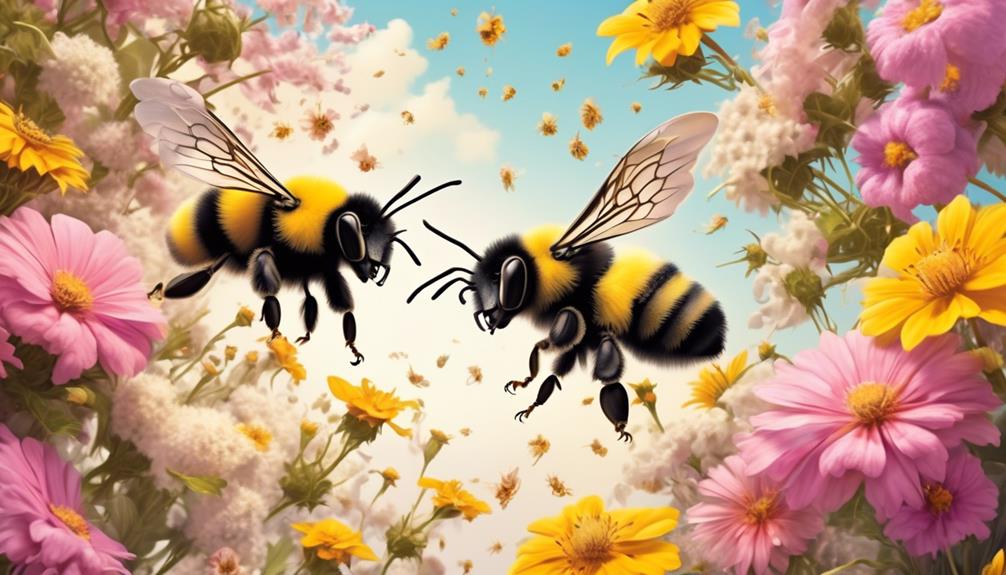
To truly grasp the phenomena of bumble bee fights, you must first delve into understanding the complex behavior patterns of these intriguing insects. Bumble bees aren't simply buzzing around aimlessly; their actions are dictated by a sophisticated social structure. In a bumble bee colony, you'll typically find worker bees, drones, and a queen. Each has a specific role and their interactions form the fabric of colony life.
Worker bees, predominantly females, are the foragers and defenders of the colony. They'll fiercely protect their hive and this is often when fights occur. Drones, the males, have a sole purpose of mating with the queen, while the queen's role is to lay eggs and ensure the survival of the colony.
When food sources are scarce or a queen dies, that's when you'll witness intense bumble bee fights as they grapple for resources or dominance. It's also common during mating season, with drones competing for the attention of the queen. By understanding these intricacies, you're better equipped to comprehend the reasons behind their aggressive encounters.
Bumble bee behavior, it turns out, is a fascinating mix of cooperation, competition, and survival instincts.
The Territory Disputes
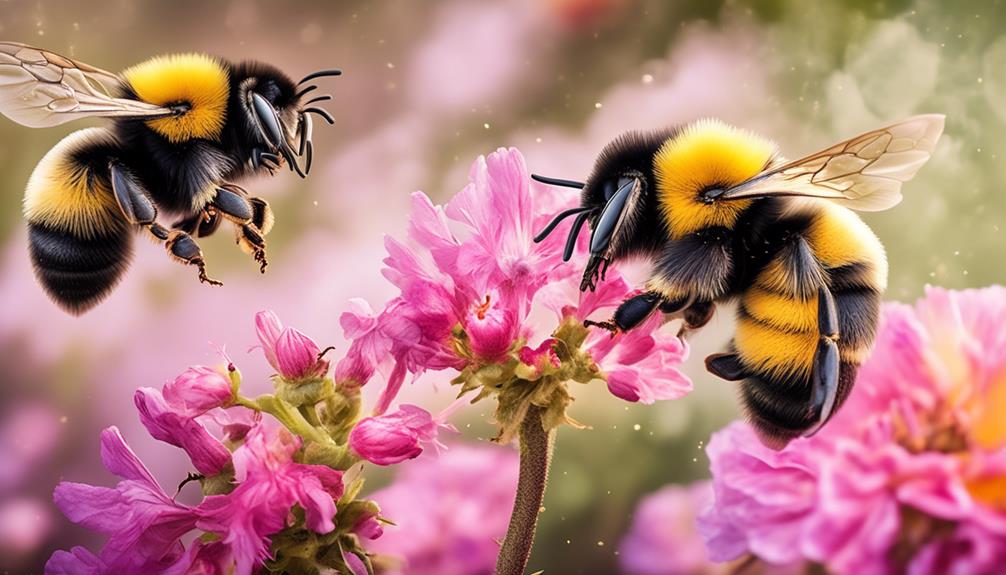
In the realm of bumble bees, territorial disputes are a common catalyst for the fights you'll observe, primarily driven by the need to secure resources and maintain colony dominance. These skirmishes aren't random outbursts of violence but strategic maneuvers rooted in survival tactics.
Each colony has an area, typically rich in nectar and pollen, that it considers its territory. The size and quality of this territory directly impact the colony's survival and reproductive success. Therefore, bees are inherently programmed to defend their territories fiercely. While you might perceive these conflicts as simply bee-on-bee violence, they're actually complex power struggles with profound implications for colony survival.
At the heart of these disputes, you'll find the queen bee, the colony's reproductive engine. She's the one who lays the eggs that will ensure the colony's future. A colony without a fertile queen can't survive. Thus, territory disputes often involve rival queens vying for control over prime real estate.
Understanding these disputes means appreciating the survival pressures that drive bumble bee behavior. They're not just flying insects but intricate social organisms, battling for survival in a world where resources are limited.
Mating Battles Among Bumble Bees
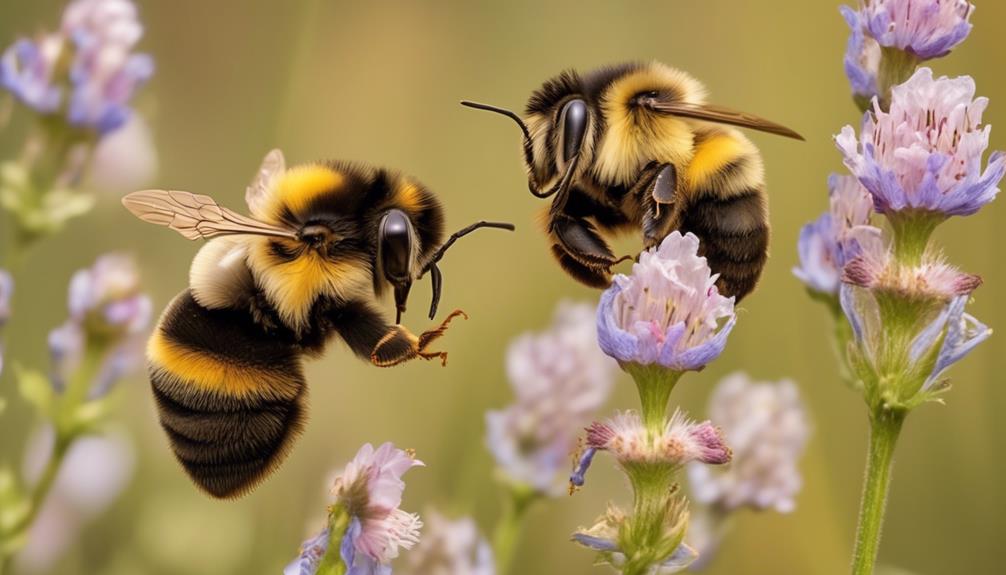
While territorial disputes largely shape the power dynamics within bumble bee colonies, it's the mating battles that truly test the mettle of these social organisms. Mating battles among bumble bees are fierce, strategic, and demonstrate the survival of the fittest paradigm.
You see, only the most vigorous males, or drones, and new queens partake in these mating battles. Once a new queen emerges post-hibernation, she releases pheromones to signal her readiness to mate. This elicits a rush of drones, eager to secure their lineage. The catch? A queen mates only once, storing the sperm for her lifetime's worth of egg fertilization.
This single opportunity ignites intense battles amongst the drones. They'll often fight to the death, seeking to be the chosen one. The winner earns the exclusive right to mate, ensuring his genetic material is passed on.
In this ruthless game, it's not just about physical power. Strategic positioning, timing, and even the ability to 'eavesdrop' on rivals come into play. Drones can detect pheromone traces left by competitors, using this information to adjust their approach.
Impact of Environment on Aggression
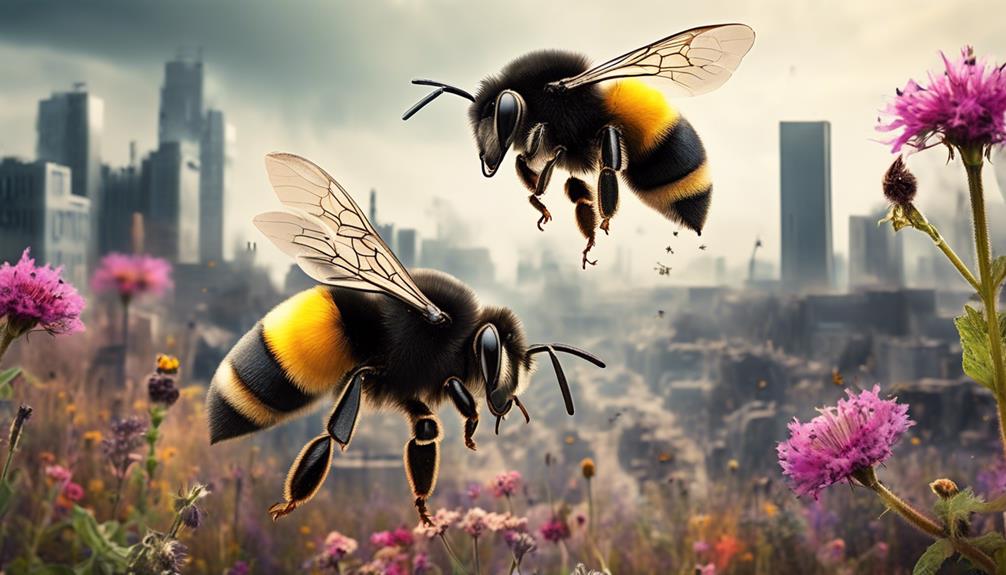
Factors like temperature, food availability, and population density significantly influence the aggression levels in bumble bees, directly affecting their mating and territorial battles. In warmer environments, the bees' metabolism ramps up, which can lead to heightened aggression. It's also important to note that food scarcity may exacerbate the situation. As resources dwindle, bees become more competitive and aggressive in their search for sustenance.
Population density plays a crucial role as well. When you pack bees into a crowded area, fights are more likely to break out. In such environments, each bee fights more aggressively to ensure its survival and reproductive success.
But it's not just about physical factors. The presence of pollution and pesticides can also impact bee behavior. Exposure to such elements can alter their neurological functions, leading to unpredictability and increased aggression.
Human Intervention and Bee Conflicts
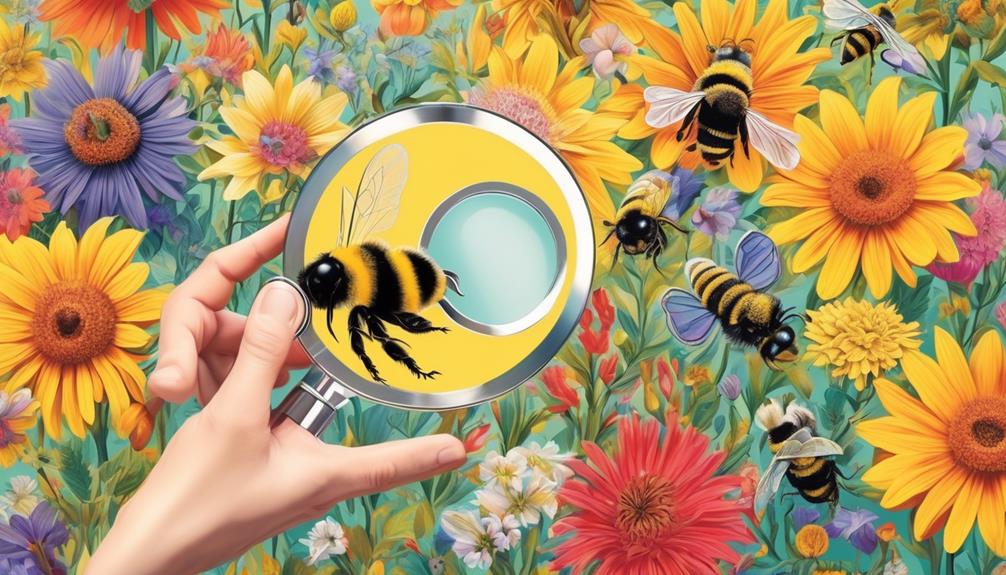
You may not realize it, but human activities can significantly escalate bee conflicts, often leading to heightened aggression and changes in their natural behavior.
Urbanization, in particular, disrupts bee habitats, forcing them into smaller areas where they're more likely to engage in fights over scarce resources. These territorial disputes may result in a higher mortality rate, affecting the overall population of these essential pollinators.
Pesticide use is another human-induced factor that can exacerbate bee conflicts. Pesticide exposure can affect bees' cognitive abilities, making them more prone to aggression. It's also been noted that certain pesticides can interfere with bees' pheromone communication, leading to confusion and heightened aggression.
Furthermore, climate change, driven largely by human actions, can upset the delicate balance of nature that bees rely on. Changes in temperature can disrupt hibernation cycles and flowering times, leading to increased competition and conflict among bees.
It's clear that human intervention plays a significant role in bee conflicts. As such, it's crucial for us to rethink our actions and their potential impact on these invaluable creatures.
Frequently Asked Questions
What Is the Average Lifespan of a Bumble Bee?
You're curious about the average lifespan of a bumble bee, aren't you?
Well, it varies. Worker bees typically live for 4 to 6 weeks, while queens can live up to a year. Males, or drones, have a slightly longer lifespan than workers, living 6 to 8 weeks.
These lifespans, however, can change due to factors like food availability, disease, and climate. So, there's no set-in-stone lifespan, but that's a general guideline for you.
How Does Climate Change Affect the Population of Bumble Bees?
Climate change impacts bumble bee populations significantly. As temperatures rise, bees lose their natural habitats, leading to population decline. Changing weather patterns also disrupt their food sources, as flowering times shift and nectar becomes scarce.
You'll find that hotter, drier conditions can increase disease and parasite prevalence, further threatening bee health. It's a complex issue, but fundamentally, climate change creates an inhospitable environment for these crucial pollinators.
What Are Some Common Predators of Bumble Bees?
Bumble bees have quite a few predators you mightn't expect. Birds, like sparrows and finches, often snatch them mid-flight. Certain species of wasps and hornets will invade their nests. Even spiders, particularly crab spiders and orb weavers, can catch these bees in their webs.
Some mammals, including badgers and skunks, will dig up bumble bee nests to feast on the larvae and honey inside.
It's a tough world out there for bumble bees.
Are There Any Specific Plants That Bumble Bees Are More Attracted To?
Yes, there are specific plants that bumble bees are more attracted to. They're especially fond of flowers with bright colors and sweet nectar, like lavender, rhododendrons, and sunflowers.
The bee's attraction to these plants isn't just about food, it's also about survival. They depend on these plants for nectar and pollen, which they need for energy and to feed their young.
How Can Humans Help in the Conservation of Bumble Bees?
You can play a huge role in conserving bumble bees.
Start by planting a variety of bee-friendly flowers in your garden.
Avoid using pesticides, they're harmful to bees.
Create small habitats for nesting and hibernation.
It's also crucial to educate others about the importance of bees to our ecosystem.
Conclusion
In summary, bumble bees' battles are primarily about territory and mating rights. Environmental factors can heighten their aggression, leading to intense conflicts.
Human interventions, though often well-intentioned, can inadvertently fuel these battles. Understanding their natural behavior and respecting their space can help maintain a balance, allowing these fascinating creatures to continue their vital role in our ecosystem.
So, next time you spot bumble bees, remember, there's more to their buzz than meets the eye.

